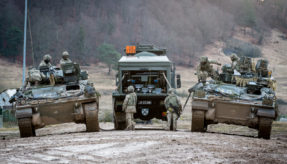
The EDA has released a Defence Data Report assessing expenditure, research, investment, and procurement between 2017-2018.
The European Defence Agency (EDA) has released a Defence Data Report covering 2018-2019 presenting key findings and analysis. The first part of the report examines total defence expenditure during that time. It reports that between 2017-2018 total defence expenditure from EDA member states was €223.4billion, 1.4% of GDP and 3.1% of total government spending. There was an increase of 3% in spending from 2017-2018, which the EDA attributes to member states recovering from the financial crash of 2008. Overall, spending decreased between 2008 and 2013 by 11% and has been rising since then. Spending is now in keeping with inflation. Defence expenditure peaked in 2006 at €227.9billion.
The next part of the report looks at investment. Investment also fell after the 2008 financial crisis. Between 2007-2014 spending dropped by 22% across member states. The figure has been increasing since 2014 and reached €44.5billion in 2018. Investment reached its peak of €46.9billion in 2010 and has yet to return to those levels. The number of member states spending 20% or more of their defence budgets investing in research, equipment, and procurement doubled between 2014 and 2018. There has been an overall positive trend since 2014 of member states increasing the portion of their defence budget being spent on investment into equipment and procurement.
The report describes similar trends for defence spending on research and technology. Spending decreased over the mid-2000s to mid-2010s, reducing from €3billion in 2006 down to €1.6billion. In 2018, spending increased for the second year in a row and reached €2.1billion, but still remains below 2008 levels. Member states agreed in 2007 to spend 2% of their defence budget on research and technology. Since then, however, none of these states has allocated more than 1.3%. The total expenditure stood at €2.1billion in 2018, with just four states spending more than 1% of their total budget on research and technology. The combined spending of eight member states accounted for 96% of overall research and technology budgets.
Spending on European collaborative research and development also hit a historic high in 2008. In that year, EDA member states spent €453million on collaborative research projects. This dropped to €153million in 2018, a decrease of 66%. The share of budget going to collaborative research from European defence budgets dropped by a similar percentage. The states dedicated on average 7.3% of total defence research and technology spending to collaborative projects falling below the target of 20%. Even adding the budget of Preparatory Action on Defence Research (PADR), the figure reaches 9.2%, despite the €40million provided under the programme for European collaborative research.
Collaborative equipment procurement went against the trend and remained steady immediately following the financial crisis, falling in 2013 to €4.7billion. Expenditure dropped again in 2018 to €6.4billion after a few years of slow recovery. Member states agreed to spend 35% of their equipment procurement budget in cooperation with other states, however, most of their budget was spent domestically, with 17.8% connected to a European framework. This peaked in 2011 with 24% of the overall budget spent on collaborative projects and dropped to a record low in 2013 of 15%. Despite the overall drop in spending to €6.4billion in 2018 from the €8billion high in 2009, the relative share of member state’s budgets being spent on international collaboration has increased each year on record.
If you would like to join our community and read more articles like this then please click here.
Budget Defence spending EDA Equipment EU member states procurement








